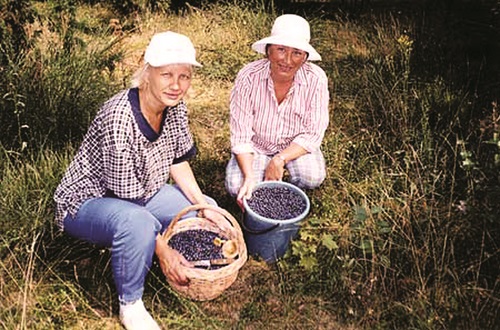In the Gomel Region this year, the first blueberry collectors headed to the forest in mid-June but were disappointed to find a poor harvest. It’s needless to compare this season with the last, when forests were closed for most of the summer. Even then, old timers recollect that the amount of blueberries was far from abundant. Experts from the National Academy of Science’s Forest Institute reveal that wild blueberry yields are lower than the usual average countrywide.

Blueberries from Belarusian woods
Things are even worse with heathberry yields: it receives two grades out of possible five. Despite favourable weather, cowberry crops will be only average in the Vitebsk and Minsk regions and below average in the Brest, Gomel, Grodno and Mogilev regions. Cranberry projections for the Brest, Gomel, Grodno and Mogilev regions are also expected to be below par. Only those of the Vitebsk region are likely to be above average.
I headed to the Gomel Region to see whether the blueberry crop would allow me to earn some extra money while on holiday, joining others at dawn, since it’s hot by mid-morning. Naturally, it’s wise to cover up, to gain protection from mosquitoes, gadflies, clegs and ticks, even though it is uncomfortable. Since no automated equipment is permitted, berries may only be gathered by hand. Fines of up to 20 base units may be given otherwise: the equivalent of a whole summer of collecting, as my neighbour learnt, to her dismay, a couple of years ago. Her example provided adequate warning to others. In fact, you can gather by hand just as easily, since even device-assisted collecting requires sorting.
Co-operative societies and private purchasers are buying berries from individual berry gatherers, paying about Br1.7-2 per kilo. With harvests low, there’s more demand than supply. Some private purchasers have even been waiting for collectors in the forest, paying 10 kopecks more than their rivals. Belkoopsoyuz has the advantage of a wide purchasing network of about 600 permanent procurement offices and more than a thousand full-time and part-time purchasers.
This year, they are also ready to buy from individuals who go berry picking, paying cash, says Oksana Skinder, Head of Belkoopsoyuz Procurement Directorate. Last year, the organisation paid Br80.5 billion in non-denominated money (Br850,000 in new) for such berries, with more than 80 percent of the berries exported, frozen, to the Baltic States, Poland, Russia, Serbia and other countries, at 1.8-2 Euros per kilo.
How much can someone expect to earn if they spend their holiday in the woods, gathering berries? If an adult can collect a 12 litre bucket of berries daily (about 7.5kg) and sells them for Br1.7 per kilo, this equates to Br12.75 a day. The blueberry season lasts for about two months, totaling about Br765 over the whole period. Of course, it becomes more difficult to gather as the season tails off, but the price also rises. A family of two adults and teenagers can earn Br3,000, unless there’s a ban due to the risk of forest fire. Violations can entail a warning or fine of up to 25 base units, rising to 25 to 50 base units if a visitor causes a fire.
Valentina Dorofey, from Zhitkovichi, tends to earn Br3,000 (worth $1,500) over the season, without too much effort. Of course, in the past, earnings would have been higher. A couple of years ago, when one Dollar (in new money) was worth 8 Kopecks, blueberries were bought at Br2.5 per kilo. Last year, the rate of pay was $2 per kilo by the end of the season, which helped the family budget. She tells us, “This year, we’re only going to the forest now and again, when the sun is not too hot, as it feels more important to earn money when the time approaches to pay land and real estate taxes. Our neighbours — of various ages, even children — love to go berry collecting.
MT reference
Cowberry collecting is permitted from 15th August in the Brest and Gomel regions, from 18th August in the Grodno and Minsk regions, and from 20th August in the Vitebsk and Mogilev regions. The cranberry season begins on 27th August in the Brest Region, from 28th August in the Gomel Region, from 1st September in the Grodno Region, from 3rd September in the Minsk and Mogilev regions, and from 6th September in the Vitebsk Region.
By Maria Drukova











